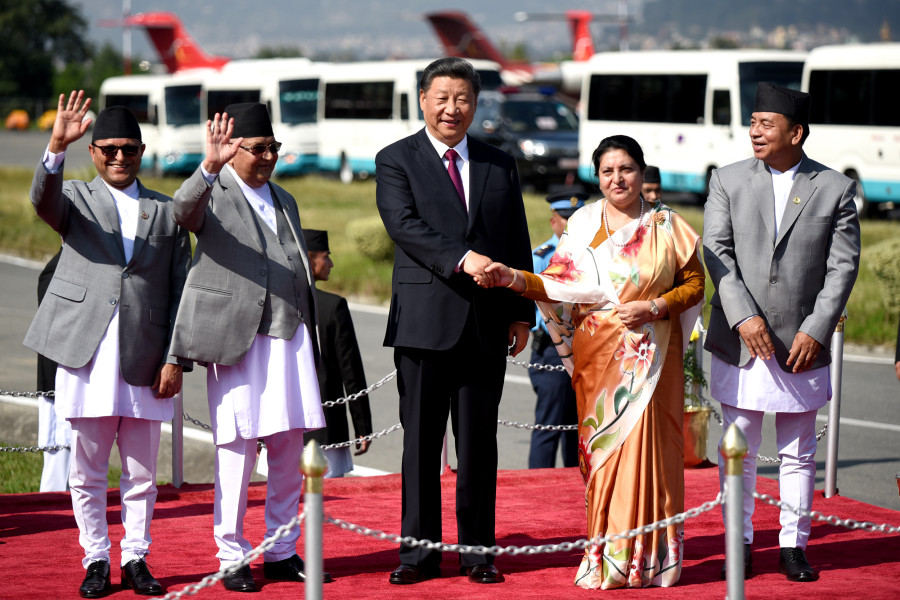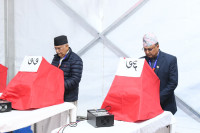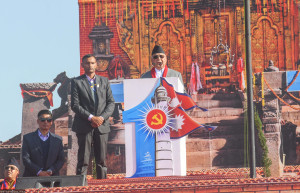Politics
Xi departs, signing over two dozen agreements and memorandums
The Chinese president returned to Beijing on Sunday after a whirlwind trip where he met with Nepali leaders and officials and announced a slew of projects and packages.
Anil Giri
Chinese President Xi Jinping concluded his two-day state visit to Nepal on Sunday with both sides extolling the elevation of bilateral relations and signing over two dozen agreements and memorandums of understanding, primarily concerning various infrastructure projects. Beijing has offered to extend financial support for all of these projects, either as grants or loans.
“The bilateral relationship between Nepal and China has entered a new phase,” reads a joint communiqué issued in Kathmandu on Sunday after Xi departed for Beijing. The two sides agreed, among others, to “respect each other’s independence, sovereignty and territorial integrity”.
During delegation-level talks, Nepal reiterated its firm commitment to ‘one-China policy’, acknowledging that “Taiwan is an inalienable part of Chinese territory” and that “Tibet affairs are China’s internal affairs”. Nepal also reiterated its commitment to not allow any anti-China activities on its soil.
After seeing Xi off at Tribhuvan International Airport, Prime Minister KP Sharma Oli took to Twitter to dub the visit of the Chinese president “immensely successful” and that it had taken “bilateral relations to new heights”.
Foreign Minister Pradeep Gyawali too expressed his gratitude to Xi on Twitter for providing good wishes, intimacy and a commitment to extending support to Nepal.
The joint statement states that the two sides have agreed to take forward the Belt and Road Initiative as an “important opportunity to deepen mutually-beneficial cooperation in all fields in a comprehensive manner, jointly pursue common prosperity and dedicate themselves to maintaining peace, stability and development in the region.”
The focus of the statement is on connectivity, especially relating to building infrastructure like ports, roads, railways, aviation and communications within what the joint statement calls “the overarching framework of trans-Himalayan Multi-Dimensional Connectivity Network”.
The joint statement also uses the phrase “strategic partnership” for the first time concerning Nepal-China relations.
During Xi’s visit, China agreed to establish the multidisciplinary Madan Bhandari University for Science and Technology in Makwanpur and pledged to extend support as soon as the Nepali side chooses a suitable site.
China has agreed to work on the detailed project report for the hotly anticipated Kathmandu-Kerung project and both sides reiterated their commitment to cooperating on the Kathmandu-Pokhara-Lumbini Railway Project. Both sides also agreed to optimise the functioning of the Jilong/Kerung port, open the Lizi/Nechung port at the earliest and build necessary infrastructure on the Nepali side of the border. Araniko Highway, the only highway linking Nepal and China, will also be reconstructed.
Both sides have agreed to hold comprehensive discussions to strengthen trade relations, with China pledging assistance to expand Nepal’s exports to China. Nepal will in turn facilitate the opening of the branches of Chinese banks and other financial services in Nepal in order to facilitate trade and investment between the two countries, according to the joint statement.
In the energy sector, both sides will “bring into full play the Joint Implementation Mechanism on Nepal-China Cooperation in the energy sector, to carry out exchanges and cooperation in the fields of hydropower, wind power, solar power, biomass energy and other kinds of new energy as well as grid systems”. Both sides will also carry out the Nepal-China Electric Power Cooperation Plan and complete it within a year.
Similarly, Nepal and China signed the Treaty on Mutual Legal Assistance in Criminal Matters and have expressed hope regarding the Treaty on Extradition. China had pushed for the signing of the Extradition Treaty but after opposition from several quarters, they settled for the Treaty on Mutual Legal Assistance, according to government officials.
There were concerns over the signing of an extradition treaty with China at a time when a similar treaty with India has been pending for long. Nepal signed an extradition treaty with India on October 2, 1953, when Matrika Prasad Koirala was the prime minister. The Indian side, however, has been demanding a revision to the treaty. In 2006, Nepal and India were close to signing an Extradition Treaty and the Treaty on Mutual Legal Assistance. Negotiations however failed due to disagreements among the parties in Nepal. Similar attempts collapsed in 2008 and 2010.
The two sides have also agreed to strengthen cooperation between law enforcement agencies on information exchanges, capacity building and training.
“In the next three years, China will offer 100 training opportunities to the Nepali law enforcement officers each year. With a view to promoting cooperation in security sector, the two sides will continue to strengthen cooperation in the exchange of visits of the security personnel, joint exercises and training, disaster prevention and education and personnel training,” the joint statement reads.
The primary opposition Nepali Congress, however, said that implementation of the agreements is key and that Nepal should not always depend on the debts from foreign countries and donor agencies.
“If we review and revisit past accords with China, we can easily find several shortcomings in implementation,” Narayan Khadka, the Congress party’s shadow foreign minister, told the Post. “Another important issue is to reduce the widening trade gap with China. We have to evaluate the reaction from neighbours and other powers regarding the visit in the days to come.”
China and India, which are also big trading partners, have agreed to set up a high-level mechanism to reduce trade deficit, but there was no agenda during Xi’s visit on ways to reduce Nepal’s trade gap with the north. Nepal’s trade deficit with China is the second highest after India. In the first month of this fiscal year, Nepal’s trade deficit with China crossed Rs 40 billion.
A new understanding was also reached between Nepal and China regarding Everest, or Zhumulangma in Mandarin, as an “eternal symbol of the friendship between Nepal and China.” The two sides have agreed to work together to address climate change and protect the environment while also jointly announcing the height of Everest. Nepal is in the midst of remeasuring the height of the tallest peak in the world.
The two countries also jointly published a 20-point list of instruments signed during the visit. This list includes memorandums of understanding between the National Planning Commission of Nepal and the National Development and Reform Commission of China, a sister-city agreement, Cooperation on Traditional Medicine, Disaster Risk Reduction and Emergency Response, and an agreement to establish a Confucius Institute at Tribhuvan University.
***
What do you think?
Dear reader, we’d like to hear from you. We regularly publish letters to the editor on contemporary issues or direct responses to something the Post has recently published. Please send your letters to [email protected] with "Letter to the Editor" in the subject line. Please include your name, location, and a contact address so one of our editors can reach out to you.




 16.12°C Kathmandu
16.12°C Kathmandu














